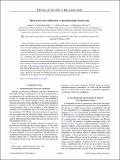| dc.contributor.author | de Lichtervelde, Aymar C. L. | |
| dc.contributor.author | de Souza, J. Pedro | |
| dc.contributor.author | Bazant, Martin Z | |
| dc.date.accessioned | 2020-05-26T20:43:59Z | |
| dc.date.available | 2020-05-26T20:43:59Z | |
| dc.date.issued | 2020-02 | |
| dc.date.submitted | 2019-11 | |
| dc.identifier.issn | 2470-0045 | |
| dc.identifier.issn | 2470-0053 | |
| dc.identifier.uri | https://hdl.handle.net/1721.1/125464 | |
| dc.description.abstract | Early recordings of nervous conduction revealed a notable thermal signature associated with the electrical signal. The observed production and subsequent absorption of heat arise from physicochemical processes that occur at the cell membrane level during the conduction of the action potential. In particular, the reversible release of electrostatic energy stored as a difference of potential across the cell membrane appears as a simple yet consistent explanation for the heat production, as proposed in the “Condenser Theory.” However, the Condenser Theory has not been analyzed beyond the analogy between the cell membrane and a parallel-plate capacitor, i.e., a condenser, and cannot account for the magnitude of the heat signature. In this work, we use a detailed electrostatic model of the cell membrane to revisit the Condenser Theory. We derive expressions for free energy and entropy changes associated with the depolarization of the membrane by the action potential, which give a direct measure of the heat produced and absorbed by neurons. We show how the density of surface charges on both sides of the membrane impacts the energy changes. Finally, considering a typical action potential, we show that if the membrane holds a bias of surface charges, such that the internal side of the membrane is 0.05Cm^{−2} more negative than the external side, the size of the heat predicted by the model reaches the range of experimental values. Based on our study, we identify the release of electrostatic energy by the membrane as the primary mechanism of heat production and absorption by neurons during nervous conduction. | en_US |
| dc.description.sponsorship | National Science Foundation Graduate Research Fellowship under GrantNo. 1122374 | en_US |
| dc.publisher | American Physical Society (APS) | en_US |
| dc.relation.isversionof | http://dx.doi.org/10.1103/PhysRevE.101.022406 | en_US |
| dc.rights | Article is made available in accordance with the publisher's policy and may be subject to US copyright law. Please refer to the publisher's site for terms of use. | en_US |
| dc.source | American Physical Society | en_US |
| dc.title | Heat of nervous conduction: A thermodynamic framework | en_US |
| dc.type | Article | en_US |
| dc.identifier.citation | de Lichtervelde, Aymar C. L., J. Pedro de Souza, and Martin Z. Bazant. "Heat of nervous conduction: A thermodynamic framework." Physical Review E, 101, 2 (February 2020), 022406. © 2020 American Physical Society | en_US |
| dc.contributor.department | Massachusetts Institute of Technology. Department of Chemical Engineering | en_US |
| dc.contributor.department | Massachusetts Institute of Technology. Department of Mathematics | en_US |
| dc.relation.journal | Physical Review E | en_US |
| dc.eprint.version | Final published version | en_US |
| dc.type.uri | http://purl.org/eprint/type/JournalArticle | en_US |
| eprint.status | http://purl.org/eprint/status/PeerReviewed | en_US |
| dc.date.updated | 2020-02-10T15:48:06Z | |
| dc.language.rfc3066 | en | |
| dc.rights.holder | American Physical Society | |
| dspace.date.submission | 2020-02-10T15:48:06Z | |
| mit.journal.volume | 101 | en_US |
| mit.journal.issue | 2 | en_US |
| mit.license | PUBLISHER_POLICY | |
| mit.metadata.status | Complete | |
